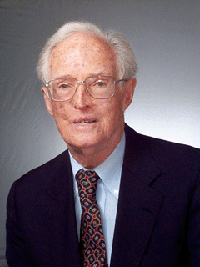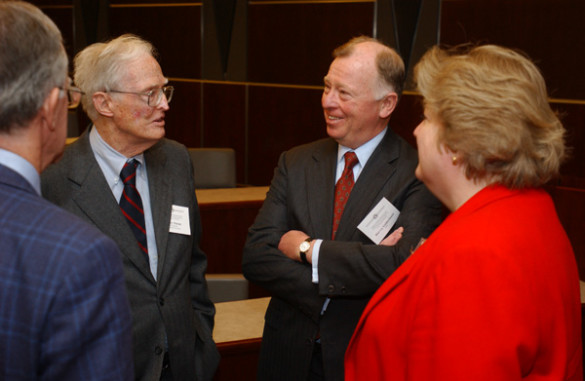
An international monetary expert and one of the most esteemed economic minds of the last century, J. Dewey Daane died Jan. 3 in Nashville at the age of 98. Daane was a Federal Reserve governor from 1963 to 1974 and a longtime professor at the Vanderbilt Owen Graduate School of Management.
Before entering academia, Daane had a distinguished career in government, including 35 years of service in the Federal Reserve system and at the U.S. Treasury Department. Appointed to the Board of Governors of the Federal Reserve by President John F. Kennedy in November 1963, Daane served as a voting member of the Federal Open Market Committee, the principal policy-making body in the Federal Reserve system.
“Dewey Daane’s legacy at Vanderbilt will be felt for generations,” Chancellor Nicholas S. Zeppos said. “The depth and expertise he brought to Owen when he joined the faculty in the school’s early years established the high standard for our curriculum in finance and financial market research. Dewey could have gone anywhere after his retirement from the Federal Reserve, but he saw his tenure at Vanderbilt as a continuation of his service to society. He enriched our special intellectual community immensely.”
View photos of Vanderbilt Business magazine’s 2014 celebration of Daane.
Daane joined Owen in 1974 as the Frank K. Houston Professor of Finance and helped establish and run Vanderbilt’s Financial Markets Research Center. In his teaching, Daane focused on the evolution of the international monetary system and on monetary and fiscal policy. He patterned his very popular seminar at Owen after the famous Fiscal Policy Seminar at his alma mater, Harvard’s Littauer School, the predecessor to the Kennedy School of Government. Daane brought in prominent guest speakers, who happened to be friends, former coworkers and highly respected economists, such as Paul Volcker, Donald Kohn, Richard Fisher, Roger Brinner, Laurence Meyer and others.
In 2009, these economic heavyweights, along with dozens of others from the Federal Reserve and financial circles, came together to give a special tribute to Daane at the Conference on Financial Markets and Financial Policy, which is held annually at Owen.
“Dewey Daane was a very old friend to me and many others who came to know him through his extraordinary career in public service, capped by his tenure as a governor of the Federal Reserve,” said Volcker, who served two terms as chairman of the Fed from 1979 to 1987 and is widely credited for ending the high levels of inflation that crippled the country during that era. “Dewey never retired. Up until his 98th year, he took enormous pride in the Vanderbilt and Nashville communities, where he became a fixture. He was very loyal to his friends, to his wife, Barbara, to the Federal Reserve, to Vanderbilt and to Nashville.”

“It is hard to imagine someone who has had more impact on the Owen School over a longer period of time than Dewey,” said M. Eric Johnson, the Ralph Owen Dean of the Owen School. “His students will best remember his seminar and the speakers.
“I stopped by the Daanes’ home on Christmas Eve to wish Dewey and Barbara well,” Johnson continued. “The warm house was beautifully decorated for the season, and it’s the warmth that Dewey and Barbara shared with seminar visitors that will never be forgotten.”
Prior to his career in Washington, Daane spent more than 20 years in public service. He lived in Paraguay for a year in the early 1950s on a mission for the International Monetary Fund to establish the Central Bank of Paraguay. Then he joined the Federal Reserve Bank of Richmond, Virginia, in various positions, including vice president and director of economic research (1957–1960) and briefly in 1960 as vice president and economic adviser to the president and board of directors of the Federal Reserve Bank of Minneapolis.
At the request of the undersecretary of the treasury, Daane transferred to Washington, D.C., to serve as assistant to the secretary for debt management, who was the principal adviser on managing the federal debt, until his appointment during the Kennedy Administration as deputy undersecretary of the treasury for monetary affairs. It was from that position that Kennedy appointed Daane to the Federal Reserve Board.
In an interview, Daane talked about his first meeting with Kennedy.
“I had an hour alone with Kennedy less than three weeks before he was killed. He was debating whether to appoint me. When I went in, he said, ‘Daane, I know where you stand on inflation—you’re a hawk—but where do you stand on growth? Because as president I have to be concerned with the economic growth of this country.’ Of course the country was in a kind of doldrums—they’d had the tax cut and so forth. I fell into the Federal Reserve jargon right away, saying, ‘Well, of course Mr. President, the best way to help the country grow is to avoid inflation.’ I still believe that, and it may be completely relevant to where we are today.”
Generally regarded as the international governor on the Federal Reserve Board during his tenure, Daane, along with Volcker, represented the United States as U.S. deputies to the ministers and governors of the Group of Ten in meetings related to international monetary crises. Daane and Volcker also acted as U.S. deputies on the Committee on Reform of the International Monetary System and Related Issues, also called the Committee of Twenty, which produced a classic blueprint for the functioning of the international monetary system.
But it wasn’t all bull markets and forecasts. Daane was well-known for his high spirits and pranks. Take the time in 1966 when Daane faced off with an actual bull. He was attending an international monetary conference in Madrid. The conference attendees, which included representatives of the 50 largest banks in the world, were invited to a famous ranch outside of Toledo where fighting bulls were bred. The most famous matador in Spain, Luis Miguel Dominguín, kept trying to get one of the American bankers to come down in the ring and face a bull. “Isn’t one of you American bankers brave enough to come down here?” Dominguín asked.
Barbara Daane recalled that “Dewey disappeared, and the next thing I knew he was in the middle of the ring wearing his gray banker’s suit. Dewey took the cape, the bull charged, caught Dewey between the horns and tossed him backwards about five feet. Luis Miguel told Dewey, ‘Always move closer to the bull.’ Dewey then performed several successful verónicas (passes of the bull), the crowd was roaring, and Dewey gracefully made his exit.”

A photo of Dewey in the bullring was on the front page of the next day’s New York Times, Washington Post and almost every other paper in the country. It also appeared in Time magazine, and the Wall Street Journal wrote up a Hemingway-like account of the incident.
When Daane left the Federal Reserve Board in June 1974, he began his career in the private sector as a chaired professor at Vanderbilt. While a faculty member, Daane was also a senior official at Commerce Union Bank and its successor, Sovran Bank (now Bank of America), in Nashville. He held a variety of senior positions at the bank, including vice chairman of the board. He also continued as an adviser to the Congressional Budget Office.
From 1979 to 1982, while still on the Owen faculty, Daane was appointed as a public director of the Chicago Board of Trade. In 1987 he became public director of the National Futures Association. He held that position until 2002. He also served as a director of the Whittaker Corporation, a large multinational company based in Los Angeles, from 1974 to 1989.
Daane continued his interest in and involvement with the Federal Reserve system until his death. In the past few years, Daane participated in multiple international conferences, including “The Credit Market Turmoil of 2007-2008: Implications for Public Policy” hosted by the Federal Reserve Bank of Chicago and the European Central Bank, and he attended the annual meeting of the International Monetary Fund (Group of Thirty) in Washington.
Over the eight decades of his career, Daane never stopped analyzing and critiquing national and international financial systems, searching for ways to make the U.S. economy work better. Until his death, Daane was a regular contributor to the Wall Street Journal’s monthly economic survey and had earned a spot in their annual U.S. economic forecasting rankings. He also contributed to USA TODAY’s quarterly economic forecast. Over his career, Daane also lent his expertise to several books and articles, including The Art of Monetary Policy.
Daane received his bachelor’s degree from Duke University, then earned his master’s and doctorate in public administration from the Littauer School, now known as the Kennedy School of Government at Harvard University. He holds the unique distinction of being Harvard’s first doctor in public administration.
Daane was married for 53 years (54 in February) to Barbara McMann Daane. They have three daughters: Elizabeth Daane Mallek, Elizabeth Whitney Daane (BA’87), and Olivia Quartel Daane (BA’92).
Memorial services for Daane are scheduled for 3 p.m. Friday, Jan. 13, at St. George’s Episcopal Church, located at 4715 Harding Rd. in Nashville.